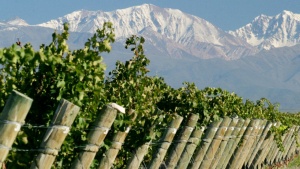Mendoza most at risk from climate change

Mendoza in Argentina is more vulnerable to the impact of climate change than any other wine growing reion in the world.
This is according to the new report by a team of European and Australian seismologists, meteorologists and scientists who analysed over 100,000 wineries in 131 countries.
“We see that Mendoze in Argentina which has earthquakes, hail, floods, the whole gamut of natural hazards, is number one,” said James Daniell of the Karlsruhe Institute of Technology in Germany and co-author of the research.
The most at risk regions after Argentina are Kakheti and Rach regions in Georgia, the southern Cahul region in Moldova, northwestern Slovenia in fourth place and followed by Yaraqui valley in Ecuador and Nagano in Japan.
The biggest threat to Italy, the world’s largest wine producer which contributes 4.9 billion litres of wine annually, is hail, frost and storms, while in France, the biggest risks will be frost, hail and storms.
Hailstorms are one of the largest yearly natural threats to European winemakers, according to the report. "
Traditional wine countries like France and Italy have seen huge losses in the past five years due to hail and frost, with many losses being recorded in the regions of Burgundy and Piedmont," confirmed Daniell.
The hail losses from 2012 to 2016 in some vineyards totaled 50 to 90% of the value of the crop and caused long-term damage to many old vines.
For Spain, hail in the northwest, frost and heat are the biggest problems that grape growers will have to contend with, while earthquakes are the biggest natural hazard for producers in California, Chile, Japan, Turkey and Greece.
Over 125 million litres of wine were lost in Chile in 2010, mainly due to the failure of steel tanks. "Earthquake-resistant design could have saved many millions of liters," Daniell says.
However, Australian producers will have to deal with frost, storms, hail and bushfires.
According to the research, wine regions will shift both southward and northward. Southern Italy and southern Spain, therefore, will see the biggest losses.
“This uses data going back from 1900 onwards,” said Daniell. “They can at least identifiy that they are at risk and ….. do something about it to mitigage it”
Some of these methods include using anti hail nets for the vineyards, tying up stored wine bottles to withstand the shock of an earthquake, using a hail cannon as employed recently by France’s burgundy region to seed clouds with stone-shriking silver iodine, or simply by taking out crop insurance.
However, it's not all doom and gloom. Global warming and climate change will result in some winners, notably northern Europe, Canada and northern USA, the UK, Tasmania and northern China which have all been identified in the report as countries and regions which will profit from warmer weather.
"The English, Canadian, and Northern China wine regions will likely increase production markedly and continue to improve their market share and quality of production," predicted Daniell.
